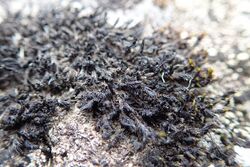Biology:Andreaea rothii
| Andreaea rothii | |
|---|---|

| |
| In British Columbia, Canada | |
| Scientific classification | |
| Kingdom: | Plantae |
| Division: | Bryophyta |
| Subdivision: | Andreaeophytina |
| Class: | Andreaeopsida |
| Order: | Andreaeales |
| Family: | Andreaeaceae |
| Genus: | Andreaea |
| Species: | A. rothii
|
| Binomial name | |
| Andreaea rothii F.Weber & D.Mohr
| |
Andreaea rothii, or Roth's andreaea moss,[1] is a species of moss in the family Andreaeaceae native to North America and parts of Europe.[2][3] This plant was described in 1807 by Weber and Mohr.[3]
Description
Andreaea rothii gametophytes sometimes form extensive black to brown cushion-like patches,[4][3] with individual shoots erect and less than 2 cm tall.[4] The leaves of Andreaea rothii are 1-2 cm wide, and have a strong costa,[4][5] which is roughly synonymous to a midrib. The leaves can be falcate-secund, curving to one side of the plant.[4][3][5] This is especially true when wet, however the plants do not alter much when dry.[4] The outline of the leaf is pear-shaped, swelling at the base and tapering to a tip,[4][3] and can also be strongly curved depending on subspecies.[4]
Distribution
Andreaea rothii grows on rocks that are wet, acidic, and exposed.[3][4] This species is found anywhere from areas of high elevation to sea-level.[4][3]
Reproduction
Andreae rothii gametophytes can be gonioautoicous—meaning the antheridia are bud-like in the axil of an archegonial branch—or cladautoicous—meaning the antheridia and archegonia are found on different branches of the same plant.[5] Like all of the Andreaeaceae, sporangia are elevated on a pseudopodium,[6] a structure resembling a seta but composed of gametophyte tissue rather than sporophyte tissue. The sporangia will dehisce longitudinally, forming slits through which spores are dispersed.[6][7] This pattern of dehiscence gives the genus its common name: "Lantern mosses".
References
- ↑ "Plants Profile for Andreaea rothii (Roth's andreaea moss)". https://plants.usda.gov/core/profile?symbol=ANRO7.
- ↑ "Roth's andreaea moss maps - Encyclopedia of Life". https://eol.org/pages/855618/maps.
- ↑ 3.0 3.1 3.2 3.3 3.4 3.5 3.6 "Andreaea rothii in Flora of North America". http://www.efloras.org/florataxon.aspx?flora_id=1&taxon_id=200000843.
- ↑ 4.0 4.1 4.2 4.3 4.4 4.5 4.6 4.7 4.8 Rothero, Gordon (2010). "Andreaea rothii subsp. falcata / subsp. rothii". in Atherton, Ian. Mosses and Liverworts of Britain and Ireland: A Field Guide. United Kingdom: British Bryological Society. pp. 314. ISBN 978-0-9561310-1-0.
- ↑ 5.0 5.1 5.2 "Andreaea rothii in Flora of North America @ efloras.org". http://www.efloras.org/florataxon.aspx?flora_id=1&taxon_id=200000843.
- ↑ 6.0 6.1 "California Moss eFlora key to Andreaea". https://ucjeps.berkeley.edu/cgi-bin/get_moss_gk.pl?genus=Andreaea.
- ↑ "Andreaeaceae". http://www.efloras.org/florataxon.aspx?flora_id=1&taxon_id=10040.
External links
- "Comprehensive Report Species - Andreaea rothii". http://explorer.natureserve.org/servlet/NatureServe?searchName=Andreaea+rothii. at explorer.natureserve.org
Wikidata ☰ Q17199908 entry
 |

